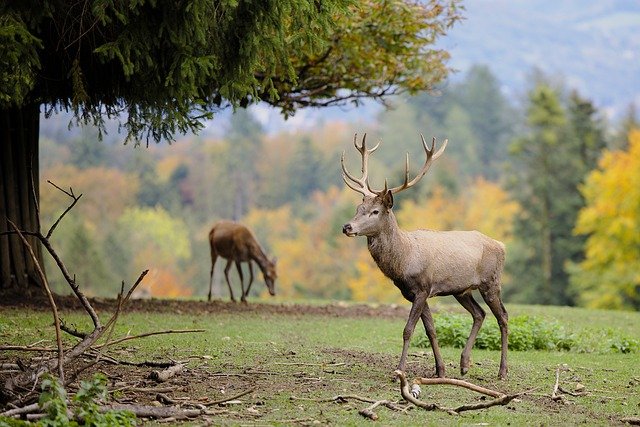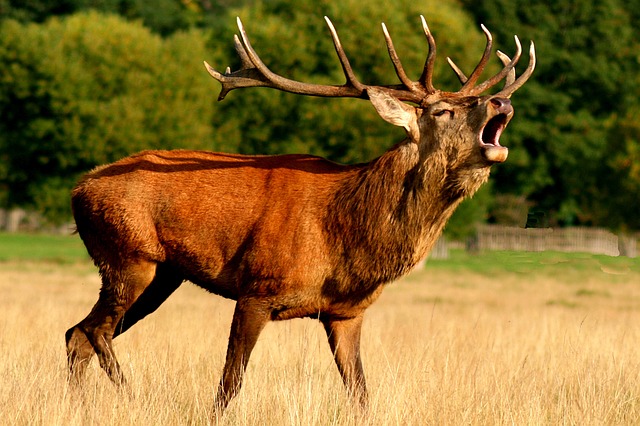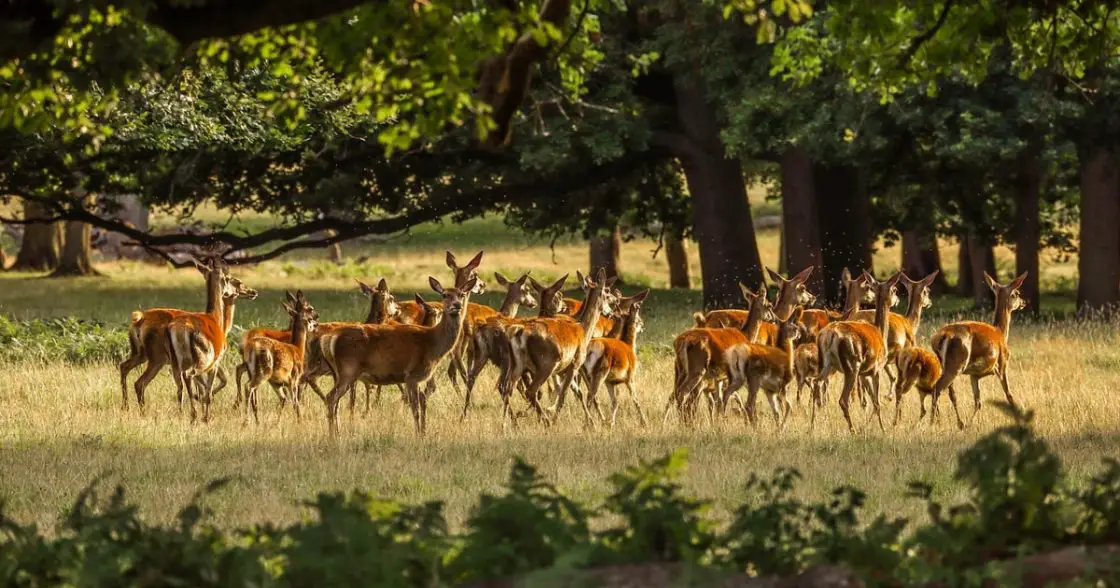All animals that have hooves are placed in a single order that is called the Ungulates. This is a Greek word, which means ‘with hooves’. The Ungulates is a large order, and contains over 200 different species of hoofed animals. On this page we’ll explore this term, the lower classifications, and deer taxonomy.
The Two Types of Ungulates
There are two main types of Ungulate:
Perrisodactyls (single-toed)
Those animals that have a hoof made up of a single toe, such as the horses and rhinos, are called Perrisodactyls. Perrisodactyl means ‘odd toed’.
Artiodactyls (two-toed)
Those ungulates which have hooves made up of two toes are called Artiodactyl. This means ‘even toed’.
There are a large number of Artiodactyl species, which including sheep, goats, antelope, cattle and deer.
Deer are Members of the Cervidae Family of Ungulates
Within the Ungulate order of animals species are grouped together into separate families. All the species in a certain family are similar to each other or share a specific characteristic or feature.
The Deer belong to the Cervidae family of ungulates.

The one feature that unites all the members of the deer family is the possession of antlers.
All deer species, except for the Chinese Water Deer, have antlers. The Chinese Water Deer is thought to have once had antlers but it is believed this type of deer lost them through their evolutionary history.
Deer also share a number of other characteristics such as having a relatively advanced form of rumination. They also have long legs that are specially adapted to fast running and which contain a cannon bone.
Two Lines of Evolution within Family Cervidae
There are two separate lines of evolution within the Deer or Cervidae family.
One group of deer evolved in North America, while the other groups center of evolution was in Asia.
New World vs Old World Deer
The difference between these two groups of deer can be seen in the metacarpal bones of the remnant 2nd and 5th toes of the foot.
- Deer that evolved in North America are called the Telenmetacarpalia or New World Deer.
- Those that evolved in Asia are called the Plesiometacarpalia or the Old World Deer.
Although they evolved in these separate parts of the world, some species from both groups have spread into different parts of the world.
For example, although the Red Deer is an Old World Deer it is now also found in America.

There are 4 subfamilies of deer, and the Odocoilinae are Telenmetacarpalia or New World Deer, and the Muntiacinae, Hydropotinae and the Cervinae are Plesiometacarpalia or the Old World Deer.
Altogether there are roughly about 40 species of deer, many of which we have information about right here.
Biologists do not always agree about counts as a species or as a subspecies. For example some biologists consider the Persian Fallow Deer to be a subspecies of the Fallow Deer while others say it is a separate species.
The same applies to the Roe deer and the Siberian Roe Deer.
Here the most widely used list of deer taxonomy for the family Cervidae is shown:
Deer Taxonomy: Family Cervidae
Subfamily Hydropotinae
- Chinese Water Deer Hydroptes inermis
Subfamily Muntiacine
The species within the Muntiacinae and the Hydropotinae subfamilies are all very similar to each other. These deer all have small rounded bodies and short thin legs. The antlers of the males are usually only short simple spikes, and the males often have well developed canine teeth that look like fangs.
- Bornean Yellow Muntjac Muntiacus atherodes
- Black Muntjac Muntiacus crinifrons
- Fea’s Muntjac Muntiacus feae
- Gong Shan Muntjac Muntiacus gongshanensis
- Indian Muntjac Muntiacus muntjac
- Leaf Muntjac Muntiacus putaoensis
- Reeves’ Muntjac Muntiacus reevesi
- Truong Son Muntjac Muntiacus trungsonensis
- Giant Muntjac Muntiacus vuquangensis
- Tufted Deer Elaphodus cephalophus
Subfamily Cervinae
The Cervinae subfamily co contains deer that are medium sized with long slender legs and long thin bodies. The antlers are often comely and branching in the males, as you may notice in North American Elk.
- Thorold’s Deer Cervus albirostris
- Visayan Spotted Deer Cervus alfredi
- Barasingha Cervus duvaucelii
- Red Deer Cervus elaphus
- Thamin Cervus eldii
- Philippine Brown Deer Cervus mariannus
- Sika Deer Cervus nippon
- Schomburgk’s Deer Cervus schomburgki (extinct)
- Rusa Cervus timorensis
- Sambar Cervus unicolor
- Chital Axis axis
- Calamian Deer Axis calamianensis
- Bawean Deer Axis kuhlii
- Hog Deer Axis porcinus
- Père David’s Deer Elaphurus davidianus
- Fallow Deer Dama dama
- Mesopotanian Fallow Deer Dama mesopotamica
Subfamily Odocoilinae
The Odocoilinae is the most diverse subfamily of deer, with their being a great range of shapes and sizes of deer species. For example the moose is the largest of all deer and lives on the open plains of the northern tundra, while the small Southern Pudu is the smallest species of deer and lives among the forests of mountainsides.
- Roe Deer Capreolus capreolus
- Siberian Roe Deer Capreolus pygargus
- Moose (Elk) Alces alces
- Mule Deer Odocoileus hemionus
- White-tailed Deer Odocoileus virginianus
- Pampas Deer Ozotoceros bezoarticus
- Red Brocket Mazama americana
- Merioa Brocket Mazama bricenii
- Dwarf Brocket Mazama chunyi
- Grey Brocket Mazama gouazoupira
- Pygmy Brocket Mazama nana
- Yucatan Brown Brocket Mazama pandora
- Little Red Brocket Mazama rufina
- Northern Pudu Pudu mephistophiles
- Southern Pudu Pudu pudu
- Marsh Deer Blastocerus dichotomus
- Peruvian Guemal Hippocamelus antisensis
- Chilean Guemal Hippocamelus bisulcus
- Caribou/ Reindeer Rangifer tarandus


